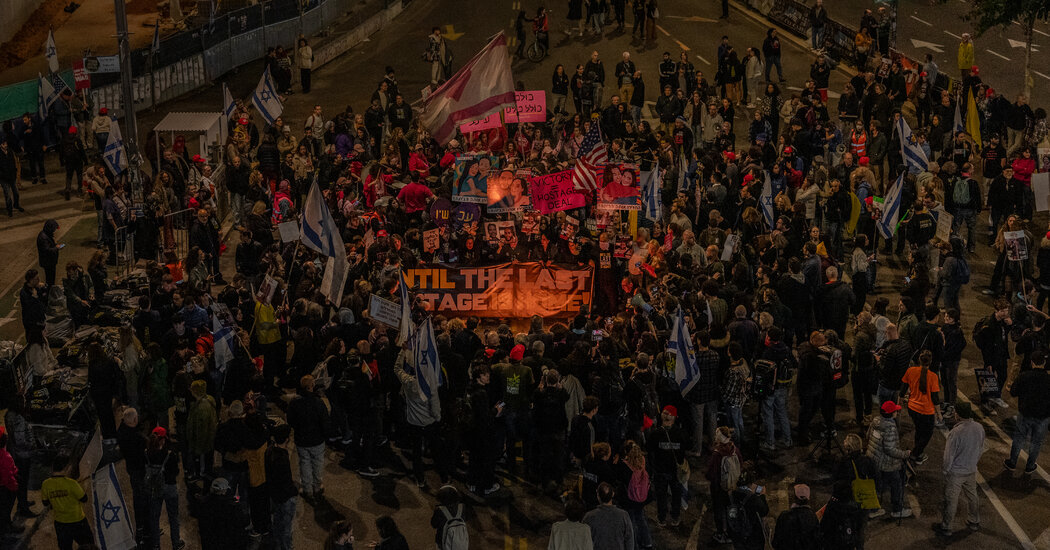
The mediating country, Qatar, announced on Saturday that the ceasefire agreement between Israel and Hamas will take effect the following day, kicking off final preparations for a truce that much of the world hopes will end 15 months of destruction in Gaza.
The deal is expected to take effect on Sunday at 8.30am local time, said Majed al-Ansari, spokesman for Qatar’s foreign ministry, which has spent months alongside the United States and Egypt fighting to broker a deal.
The Israeli cabinet approved the deal early Saturday morning, after hours of deliberations and amid rifts within Prime Minister Benjamin Netanyahu’s governing coalition. The approval cleared a final hurdle, raising the hopes of Israelis who want to see their loved ones returned and Gazans who survived one of the most intense bombing campaigns of the 21st century.
“It’s a mix of joy, sadness and longing for a new beginning,” said Mariam Moeen Awwad, 23, who has been displaced from her home in northern Gaza six times since the war began.
Ms. Awad had planned to move into her newly furnished apartment with her husband in November 2023. The war derailed those plans, leaving the couple in an overcrowded property and longing to return home, she said, “if he’s still there.” .
In Israel, authorities have begun preparations to welcome home dozens of hostages, without knowing whether they will return malnourished, traumatized or dead.
In his first statements after the ceasefire was approved, Prime Minister Benjamin Netanyahu said in a speech Saturday evening that 33 hostages, “most of them alive,” would be released in the first phase of the deal.
Defending the deal, he also argued that Israel had achieved major strategic gains in recent months, including the killing of top Hamas leaders. “As I promised you, we have changed the face of the Middle East,” he said.
According to an Israeli military official, three reception points have been set up to accommodate hostages along the Gaza border. The personnel will be made up of Israeli soldiers, as well as doctors and psychologists, said the official, who spoke on condition of anonymity in accordance with protocol.
The release of the hostages is expected to be the first such exchange since a week-long ceasefire at the start of the war.
“Those who were freed then were already poorly nourished,” Hagar Mizrahi, a senior Israeli Health Ministry official, said of the hostages freed during the 2023 truce. “Imagine their situation now, after another 400 days. We are extremely concerned about this.”
Many of the women, elderly men and other hostages who will be returned are believed to have been held in Hamas’ tunnel network in Gaza, in conditions that could leave physical and psychological scars. Israeli hospitals are preparing isolated areas where hostages can begin convalescence in privacy.
“Last time, we saw the Red Cross moving hostages, and some of them were running towards relatives, hugging them,” said Einat Yehene, a clinical psychologist working with the Hostage Families Forum, an advocacy group. “It won’t be easy and not even this time, given the physical and emotional conditions we expect.”
In exchange, hundreds of Palestinian prisoners will be freed. The total number of prisoners to be released and their identities were among the many points of contention involved in negotiations for a settlement.
The new agreement also provides for the daily entry into Gaza of 600 trucks loaded with aid and negotiations on the withdrawal of Israeli forces from the territory and a permanent end to the war.
Such negotiations are likely to be bitter and difficult, like the months of talks that led to this week’s ceasefire agreement. Netanyahu is already facing an internal revolt within his governing coalition, from which his far-right partners have threatened to resign over their opposition to the deal.
They called for the war to continue to eradicate Hamas, which led the October 2023 attack on Israel that killed about 1,200 people, took 250 others hostage and started the war.
Netanyahu also faces pressure from numerous Israelis who want the return of all hostages, and from outgoing U.S. President Joseph R. Biden Jr. and President-elect Donald J. Trump, who both want an end to the war .
In his speech, Netanyahu said the deal preserves Israel’s right to return to war against Hamas if it wishes. The agreement also allows Israeli forces to remain in a buffer zone along Israel’s border with Gaza and Gaza’s border with Egypt, he added, at least during the initial phase.
“If we need to fight again, we will do so in new ways and with great strength,” he said.
Another uncertainty about how the deal might play out stems from the chaotic and devastated conditions in Gaza, where tens of thousands of people have been killed since the war began and hundreds of thousands of others live without homes, clean water or food supplies or medicines. .
The Israeli campaign has left a power vacuum in much of Gaza, and lawlessness has proven to be a dangerous factor in efforts to get aid to people in need. Organized looting has repeatedly swept away supply trucks, including a convoy of 100 trucks carrying United Nations aid late last year.
Israel has continued to strike Gaza since the ceasefire was announced, and in the past 24 hours, 23 Palestinians have been killed and 83 others wounded, Gaza’s health ministry said on Saturday morning. More than 46,000 people have been killed in Gaza since the war began, according to the ministry, which makes no distinction between combatants and civilians.
Desperately needed aid is expected to flow into Gaza once the ceasefire begins. Egypt, which borders the enclave, stepped up preparations to provide assistance, including food and tents, on Friday, according to Al Qahera News, an Egyptian state broadcaster.
